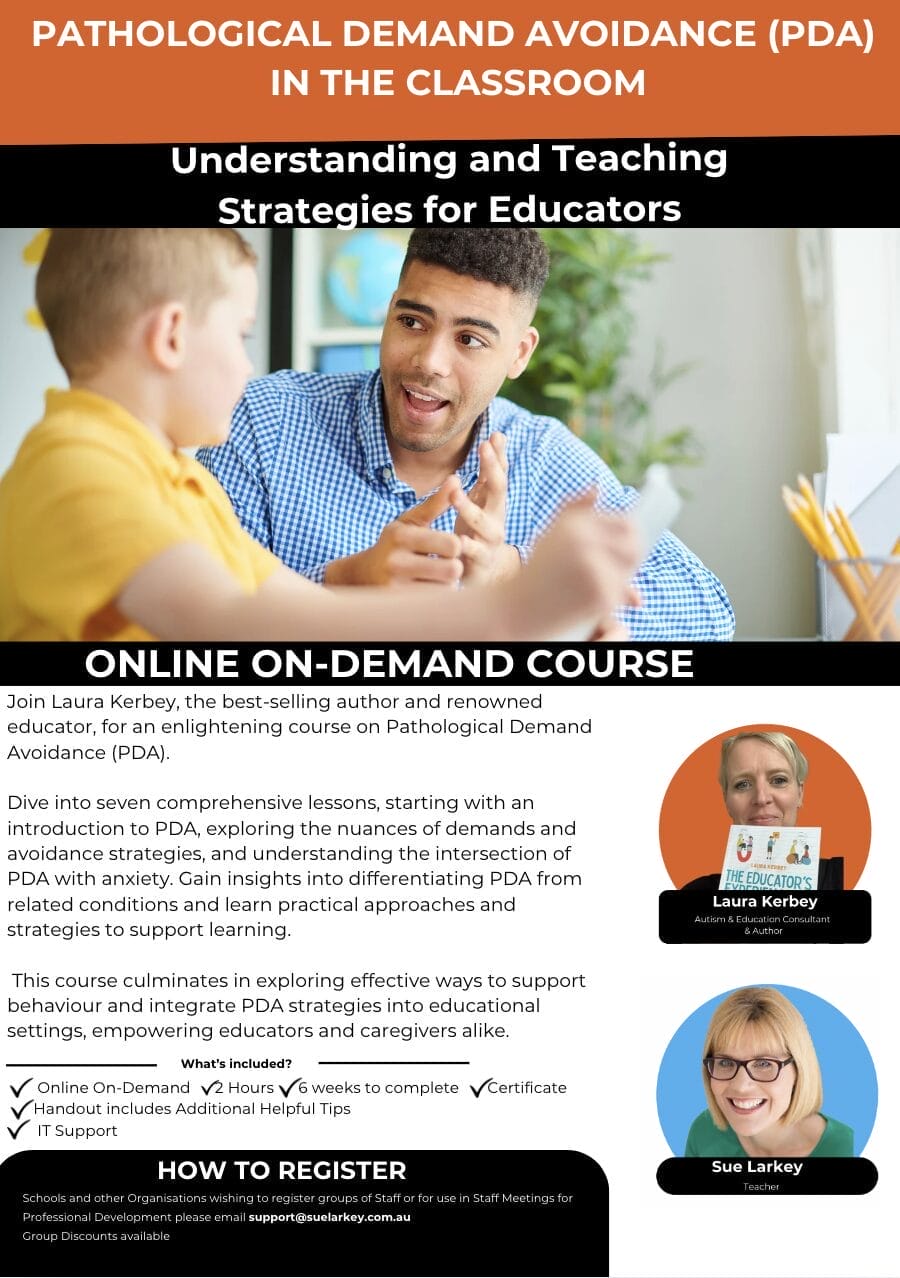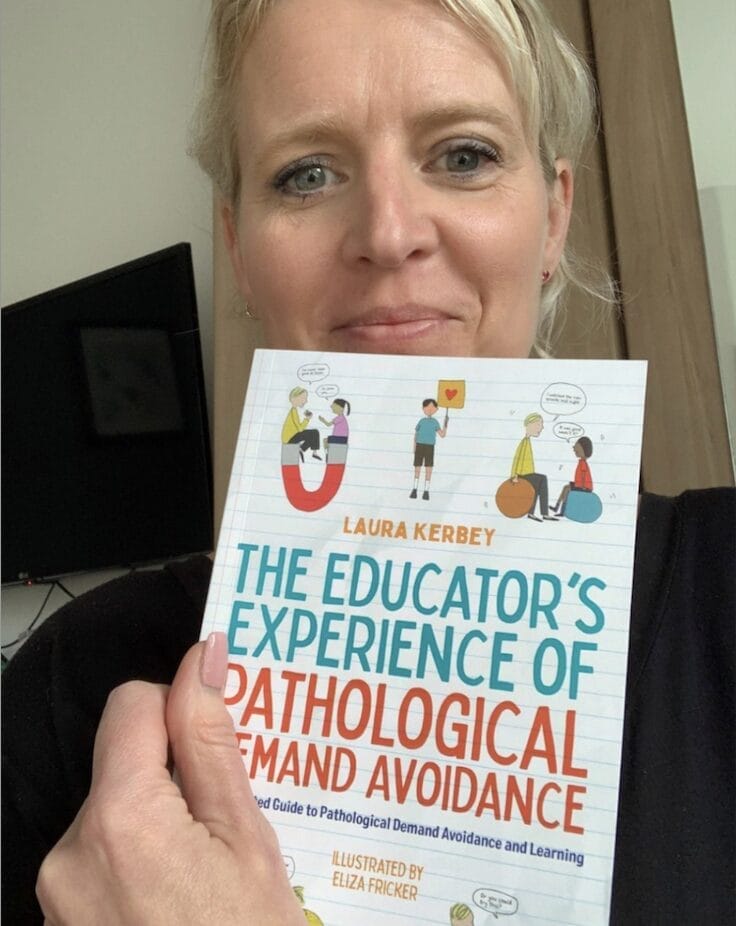Behaviour Strategies for Teacher Assistants to Support Neurodiverse Students
Course for Teacher Assistant
✅ 2 Hours, 7 Lessons
✅ Online On-demand Course
✅ Transcript to refer back to forever
✅ Certificate of Completion
✅ Handout includes Additional Helpful Tips
✅ Email questions directly to Sue Larkey
✅ 100% Money back – if, after the first two lessons, you decide the course is not for you
✅ IT support
REVIEWS ⭐️ ⭐️ ⭐️ ⭐️ ⭐️
In Anna and Sue's course you will learn:
TEACHER ASSISTANT PART 3 Understanding Autism Spectrum and Neurodiversity
This course provides a comprehensive overview of the autism spectrum and neurodiversity, helping you understand each student’s unique needs. You’ll explore how sensitivities to sound, sight, and smell impact behavior and learn to tailor your approach to suit individual differences.
Behaviour as Communication
You’ll learn that behavior is a way students communicate when they can’t express themselves verbally. This module teaches you how to observe, gather data, and use communication strategies to decode and address the meaning behind their behaviors, tailoring your responses to individual students.
Generalisation and Adaptability
Skills taught in one environment don’t always transfer to others. Here, you’ll discover how to explicitly teach generalization, using visual supports and simplified choices to reduce overwhelm. Modeling mistakes will also be emphasized to help students adapt and learn resilience.
Lesson Outline
Lesson 1: Understanding Autism Spectrum & Insights into Behaviour
- Overview of Autism Spectrum
- What is Neurodiversity?
- Understanding each student as an individual with unique needs
- Hypersensitivity or hyposensitivity to sound, sight and smell
Lesson 2: Understanding that Behaviour is a form of Communication
- Behaviour is used to communicate wants, needs, or reactions
- Students use behaviour when they lack other ways to express themselves
- Strategies must be tailored to the individual
- Using observations, data and communication to decode the meaning behind behaviours
Lesson 3: Generalisation, Adaptability and Choice Making
- Skills taught in one setting may not transfer to new environments
- Be explicit in showing how skills apply across different contexts
- Provide visual supports and practice to aid generalisation
- Simplify choices to 2-3 clear options to avoid overwhelming the student
- Model making mistakes and how to fix up
Lesson 4: The impact of Executive Functioning on Behaviour
- Executive Function skills include organisation, working memory and emotional control
- Provide visual supports to support EF difficulties ie: schedules, timers, checklists
- Teach students to recognise and verbalise their emotional states
- Introduce tools like the “spoons” metaphor and “low and slow” days
- Don’t take behaviours personally – usually not aimed at you
Lesson 5: Behaviour & Anxiety
- Anxiety is often a major cause of behaviour
- Recognise signs of anxiety
- Regulating Anxious States
- Divert, withdraw, or offer solitude fi a child seems very anxious
- Adjusting Expectations
Lesson 6: Behaviour Strategies
- Don’t try to tackle every behaviour at once – choose your top priorities
- Build skills sequentially rather than trying to extinguish behaviours
- Be consistent in your reactions day-to-day as much as possible
- Review preventative strategies if behaviour plans aren’t working
Lesson 7: Creating a Behaviour Plan
- Developing a Plan using the Template Provided
- Identify underlying issues driving the behaviour through observation & data
- Use visual supports, social stories, peer modelling, and practice
- Plans should be collaborative and involve the child where possible
- Case Study of how to use behaviour plan
Lesson 8: Applying Lessons to Common Behaviours
- Swearing & Bad Language
- Hiding & Running Away
- Not Leaving Activity They Like Doing
- Calling Out
- Doesn’t Want to Do Their Work
- Fear of Making Mistakes
Lesson 9: Conclusion
- Seeing Behaviour as Communication
- Teaching Replacement Skills
- Taking a Collaborative Approach
- Adjusting Expectations
- Tailoring Strategies to Individuals
- Patience, Consistency and Relationships
Master Teacher Assistant Behaviour Strategies with Anna Tullemans and Sue Larkey
Executive Functioning and Behaviour
Executive function difficulties—like organization and emotional control—often drive behaviors. You’ll explore strategies like visual aids, checklists, and tools like the “spoons” metaphor to support students, teaching them to recognize emotions and manage behavior more effectively.
Behaviour and Anxiety
Anxiety is a key cause of challenging behaviors. This module helps you identify signs of anxiety and offers strategies like offering solitude, adjusting expectations, and regulating anxious states to improve behavior and reduce stress in students.
Creating Behaviour Plans
You’ll learn how to develop effective behavior plans, identifying the root causes of behaviors and using strategies like visual supports and peer modeling. The course also covers common challenges like swearing or running away and offers practical solutions you can implement immediately.
Understanding PDA in Education
This course offers a comprehensive exploration of Pathological Demand Avoidance (PDA), a behavior profile within the autism spectrum. Designed for educators, it provides insights into the unique challenges and strategies for supporting students with PDA. Led by Laura Kerbey, a respected expert in the field, participants will gain valuable knowledge to foster an inclusive and supportive learning environment.
What Our Participants Say
“This course transformed my teaching approach. The insights into PDA were invaluable and have made a significant difference in my classroom.”
“Laura’s course is a must for any educator. The practical strategies offered are easy to implement and highly effective.”
“I now have a deeper understanding of PDA and how to support my students better. Highly recommend this course!”
“The course content was comprehensive and engaging. It provided me with the tools I needed to make a positive impact on my students’ learning experiences.”
“An excellent course that offers practical advice and strategies. It has helped me become more empathetic and effective in my teaching.”
Pathological Demand Avoidance (PDA) in the Classroom:
Understanding and Teaching Strategies for Educators
✅ 2 Hours, 7 Lessons
✅ Online On-demand Course
✅ Transcript to refer back to forever
✅ Certificate of Completion
✅ Handout includes Additional Helpful Tips
✅ Email questions directly to Sue Larkey
✅ 100% Money back – if, after the first two lessons, you decide the course is not for you
✅ IT support

Enrol in this Course with Confidence
100% Money Back Guarantee & Zero Risk Promise
If you start this course and find that it is not for you, we will refund 100%, no reason required. Just email support@suelarkey.com.au

PDA Online Course
Includes full access to all course materials and a certificate of completion.
To have an invoice sent to your organisation for payment please email support@suelarkey.com.au.
Course Price: ON SALE $79 per person (normally $149 pp)
Group Bookings
For groups of 6 or more please email support@suelarkey.com.au to receive the discounted price. Payment can be made online using a code you will receive of via an invoice we can provide.
Course Price for a group of 6 or more: $99 per person
Meet Laura Kerbey

Laura Kerbey is a best-selling author and a highly respected educator with over 21 years of experience working with young people who have a range of learning difficulties, with a particular passion for supporting and teaching individuals on the autism spectrum. Holding qualifications including MBPsS, BSc (Hons), PGCE, PGCE (Autism), and NPQH, Laura has spent much of her career in schools and colleges, working closely with students, their families, and staff to address the unique barriers to learning that autism can present. She is deeply attuned to the frustration and anxiety that these challenges often cause for students, parents, and educators alike.
Laura’s empathetic and tailored approach has enabled her to work effectively with young people and empower educators and staff with the skills they need to do the same. She offers accredited Autism training at Level 2 and Level 3, as well as Level 2 training on Pathological Demand Avoidance (PDA) accredited by The London Region Open College Network.
Meet Sue Larkey

Sue Larkey is a highly respected educator, author, and speaker with extensive experience in autism spectrum disorder (ASD). She has taught students in both mainstream and special education settings, combining practical experience with extensive research. Sue holds a Master’s in Special Education and has completed the research sections of her Doctorate in Education.
Sue’s podcast, the “Sue Larkey Podcast,” has over 1.3 million downloads across more than 200 episodes and is the #1 ranked Apple Podcast in Australia in the Course category. Her podcast resources are used by leading universities, including Monash University and Canberra University, to train teachers. She also has a global following, with over 135,000 subscribers to her weekly e-newsletter in more than 30 countries and a community of 130,000 Facebook followers.
Sue has authored over 18 books aimed at educators, teacher assistants, and parents/carers, and is a former winner of the Naturally Autistic International Award for Community Contribution. She has delivered hundreds of speeches at both international and national conferences, earning recognition as a trusted source of knowledge, compassion, and inspiration for educators, support workers, and families.
PODCAST: PDA with Sue Larkey and Laura Kirby
Introducing the Podcast “Guide to Pathological Demand Avoidance”, a beacon for educators seeking to understand, connect with, and empower these unique learners.
Frequently Asked Questions
- When do we get the certificate?
Immediately upon completion of the course.
- Can this Course Count towards my Professional Development?
Yes. Completing Pathological Demand Avoidance (PDA) in the Classroom: Understanding and Teaching Strategies for Educators in the priority area of Students/children with Disability addressing Standard Descriptor(s) 1.2 and 1.5 from the Australian Professional Standards for Teachers
- What age is the course appropriate for?
The course is appropriate for supporting primary and secondary age children.
- Can the course be watched as a group?
Yes, the course can be watched together as a group, however each person participating needs to be individually registered.
- How long do I have to do the course
The initial access period is set to 6 months but we will always extend this if you need longer to complete the course.
- Can I rewatch the course?
Yes, you can rewatch the course as much as you like during the 6 months that the course is available to you.
- I am having technical issues, what do I do?
Contact our team on support@suelarkey.com.au
- When is the course on?
It is an online On-demand course, so it can be watched whenever it suits you.

